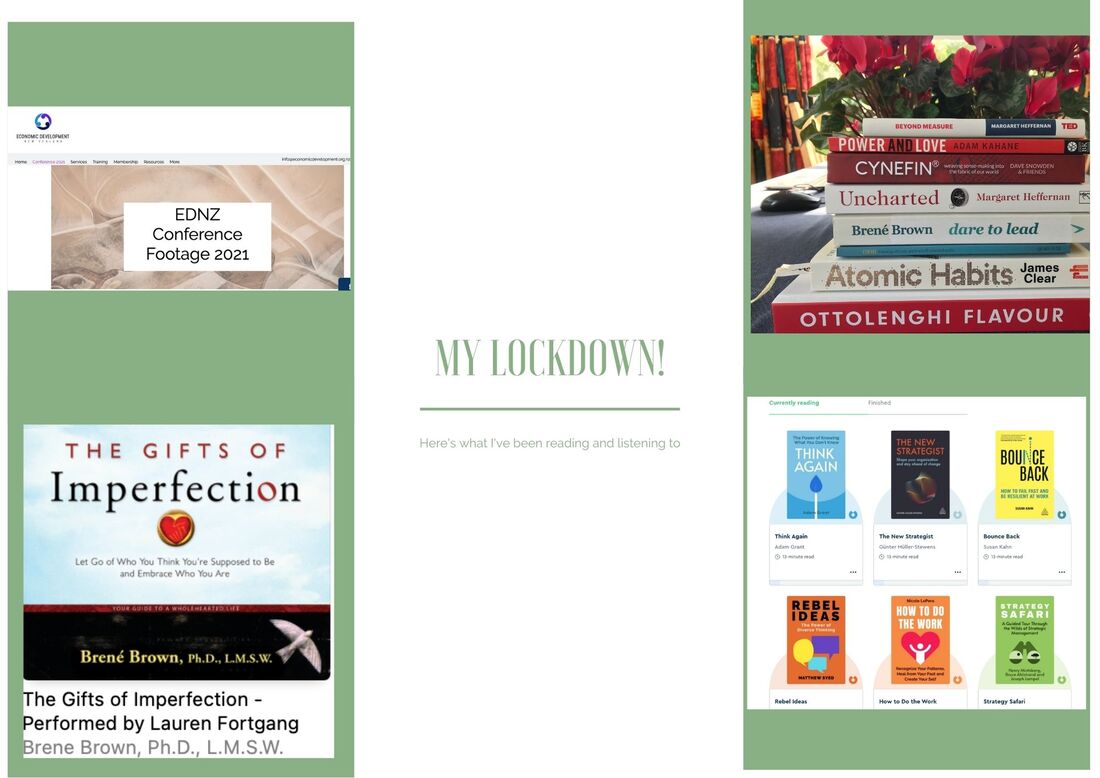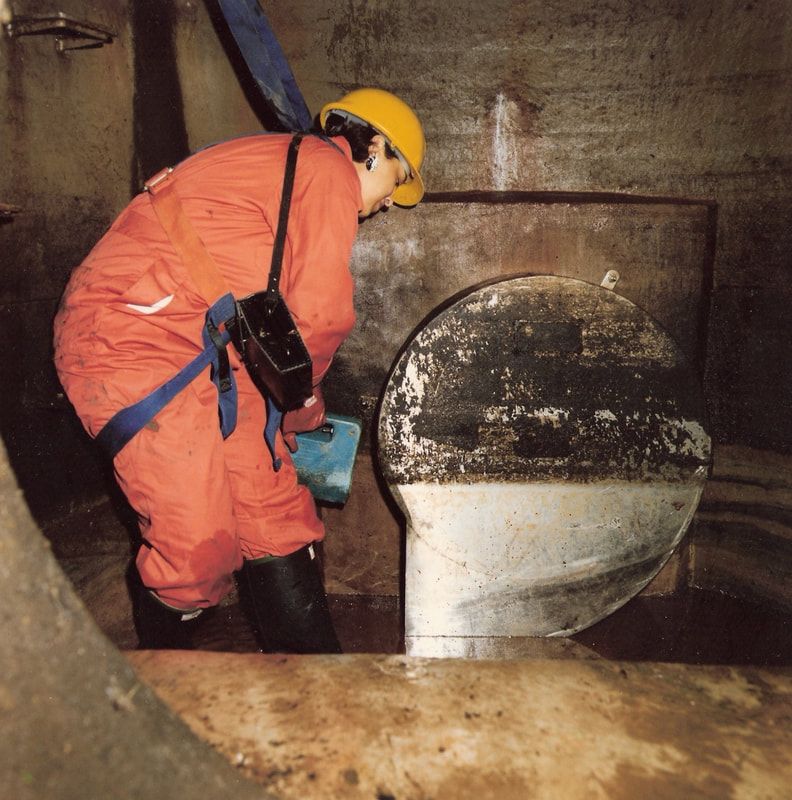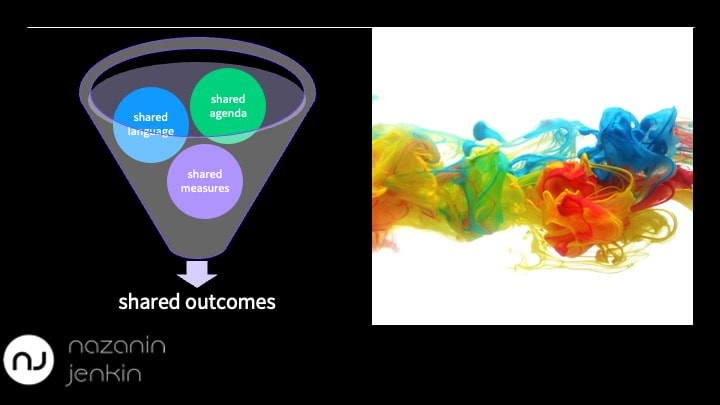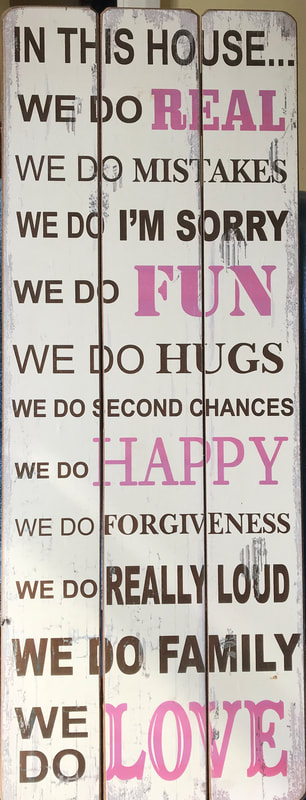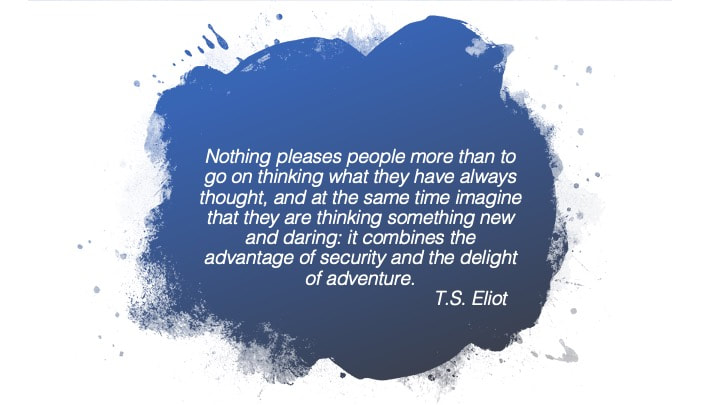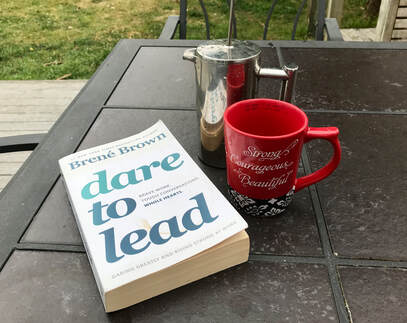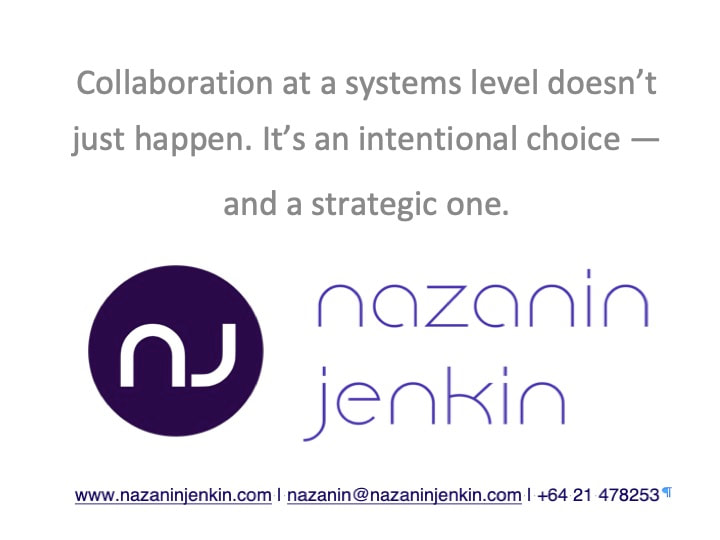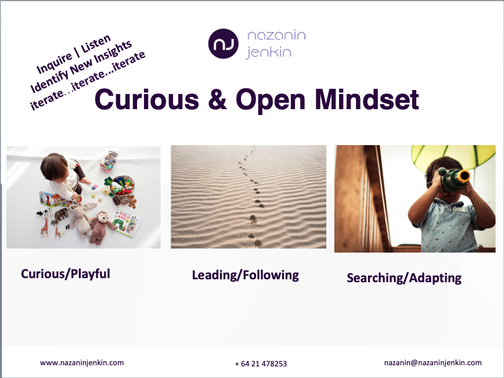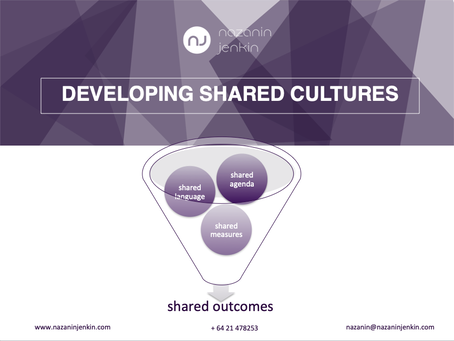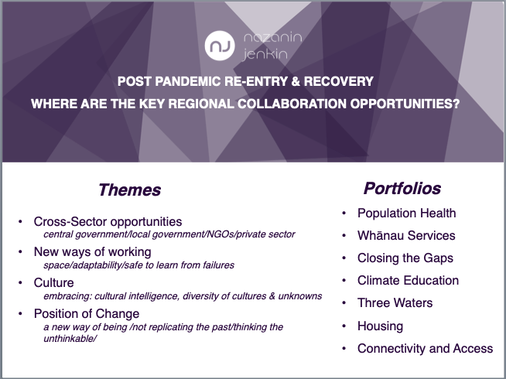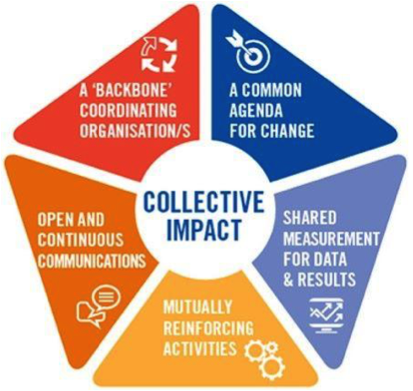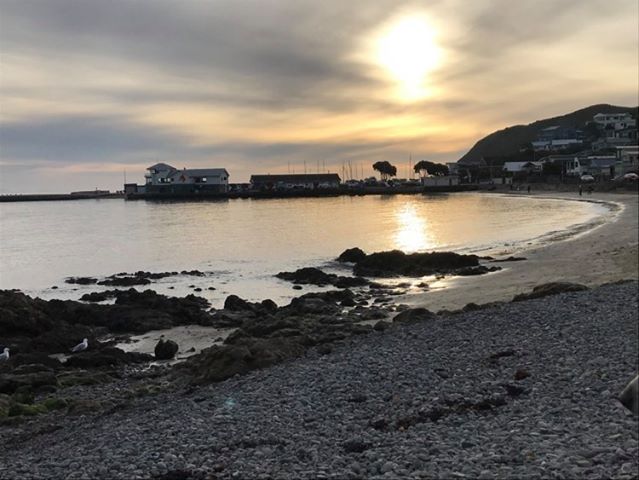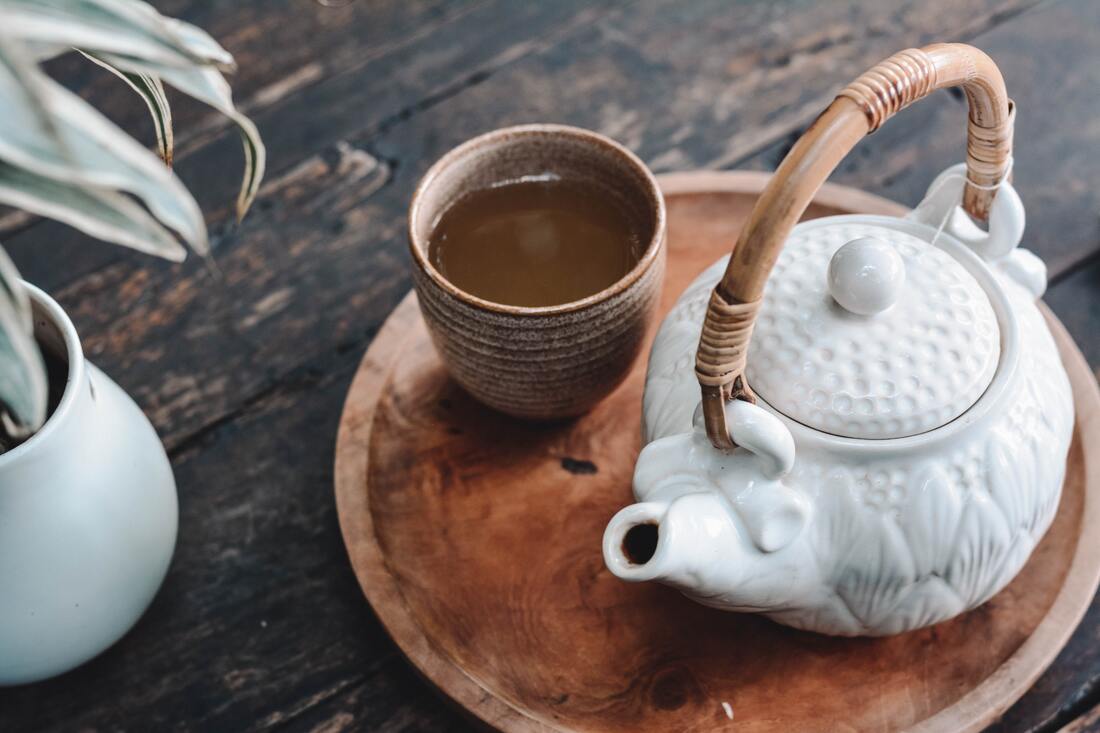I'm thinking about... |
|
Everyone loves the fruit of the harvest, but not everyone wants to engage in (the often tough) work/mahi that precedes the harvest.
It's the same with collaborations and partnerships. Folk love to be part of the success story and partake of the collective fruit that comes forth from the generosity, strength and courage of often a few courageous champions who lead the way. But successful collaborations and partnerships only happen because someone was prepared to get uncomfortable and put in the hard mahi for collective benefit. I've been revisiting Brene Brown's the Gifts of Imperfection and this quote struck me today "...symptomatic of our cultural fears. We don't want to get uncomfortable. We want a quick and dirty how to list for happiness." I think this is true for many things - we we do not want to get uncomfortable and we often avoid conflict at all costs - we just want a quick (and dirty!) how to list for achieving an expressed outcome or desire. Complex opportunities need space and time for inquiry and exploration. We frequently observe that experts disagree (as demonstrated through COVID and across the NZ Three Waters discussions). This got me thinking about three particular areas that are interwoven into the facilitation of complex collaboration workshops that are often uncomfortable and infrequently talked about openly:
Any you want to add to this list? Keen to explore these through the week. Watch this space... It's only been a couple of weeks, not months and months, and there is so very much in my world to be thankful for - but, like many others it seems, I've struggled a bit this time round in lockdown. I was feeling a little low as we went into lockdown (mentally and spiritually), which resulted in my body reacting physically with a nasty skin infection, which led to a level 4 GP virtual consult - then a visit, some very minor surgery and antibiotics. Happy to report - all healed now and feeling fully better, and the sun is shining brightly today 😀 But this was a good lesson for me: to take time to practice self compassion, refill my tank and find ways to feel more connected despite lockdown. Sometimes , I'm a slow learner!!! So what did I do? In addition to getting some medical help (I have an absolutely fab GP!!!) - I stopped putting the guilt trip on myself to create and took time to rest and dip into some old & new material. My upcoming gig has a delayed start date due to lockdown, so I had some space (I appreciate it's not as easy for everyone). So here's a summary of what I've been dipping in to (rather than reading front to back) over the last couple of weeks...I'm a slow reader, so I tend to have a smorgasbord of books, audio books, podcasts and book summaries on Blinkist (an app I love 👍🏼). On reflection this smorgasbord seems to fall into two categories: thought leadership and personal wellbeing. Thought Leadership I've returned to material from four authors that have inspired me and taught me much over the years and in particular over recent months, as I prepare new material for workshops and webinars. Margaret Heffernan (Entrepreneur, Writer & Keynote Speaker)) Uncharted: How to map the future together was written before the pandemic and published last year - I've been dipping in and out of it since then. Life and the world are unpredictable, we need to learn new skills at all levels to respond differently. Margaret offers some really good thinking as we navigate the future. In complex environments, efficiency is a hazard, not a help; being robust offers more powerful alternatives. Cathedral projects, developed over centuries, show how much can be achieved in facing the unknown. Being prepared is more creative and more effective than planning. Once you accept that no one knows the future, possibilities proliferate." This led me to pull out from the bookshelf an older book from MH, Beyond Measure. A book that seems even more relevant in this complex uncertain environment. In fact, as we were processing the NZ Level 4 announcements, I was engaged in the third installment of the 2021 ANZOG/CPI Reimagining Government webinar series "Meaningful Measurement". In his post event Medium article David Murikumthara from CPI identifies three key themes from the webinar, which align well with ideas in MH's book:
Dave Snowden (Author of the Cynefin Framework) I first came across the Cynefin Framework when I was in the thick of my MBA research. Around the same time Dave visited NZ and I jumped at the opportunity to sign up for his masterclass. Since then I've been following Dave and the Cynefin community's work, as well as integrating the framework into my workshops and approach. The book, Cynefin: Weaving sense-making into the fabric of our world was also published last year and, much like Uncharted, I've been dipping in and out of it. This year, after releasing the EU Field Guide: Managing complexity (and chaos) in times of Crisis, Dave invited folk to be part of a global group to populate the Cynefin wiki. I put up my hand and after some online training from Dave, joined forces virtually with an eclectic global crowd to get the work done. It's been great to build wider community connections as well as build a deeper understanding of the framework and associated tools.My personal input focused on the Triopticon page - "a formal workshop method that facilitates the interaction between different disciplines, participants, ideas and beliefs, encouraging the sharing of conflicting points of view and thus the analysis and synthesis of elements of disagreement between traditionally diverse fields in order to enhance understanding". This really got me thinking about my work as a facilitator or convener of complex conversations and opportunities - what that looks like and involves. Returning to the book again I am finding deeper and more meaningful insights, particularly pertaining to complex systems facilitation. Cynefin means the place of your multiple belongings, a multi-threaded and entangled path that makes you what you are, and continues to change over time. Learning to live with that and to work with it is key to maturity and impact. I haven't always been successful but I have tried. (Dave, from the book (p55)) The need to act in concert, to work together, is key but that working together recognises what, from a complexity science perspective, we would call requisite diversity. We don't want to homogenise but to create coherent heterogeneity, or the ability to come together in common need for common purpose without the loss of what made us distinctive in the first place. (From the Field Guide, p66) Adam Kahane (Collaboration Guru) I seem to remember a colleague introducing me to Adam's work over a decade ago. All his books are filled with wisdom born out of real life practical experience. I've learnt much from all of them and on this occasion it was Power and Love: A theory of social change that I pulled off the bookshelf. I am really looking forward to my pre-ordered copy of his latest book Facilitating Breakthrough: How to remove obstacles, bridge differences, and move forward together arriving. In order to address our toughest challenges, we must indeed connect, but this is not enough: we must also grow. In other words, we must exercise both love (the drive to unity) and power (the drive to self-realisation). If we choose either love or power, we will get stuck in recreating existing realities, or worse. If we want to create new and better realities - at home, at work, in our communities, in the world - we need to learn how to integrate our love and our power. Brené Brown (Researcher and Storyteller) Brené's work has been a constant companion for some time. Dare to Lead: Brave work, Tough conversations, Whole Hearts is my most gifted book and a must read for all leaders and emerging leaders. The book outlines four skill sets:
Leadership is not about titles or the corner office. It’s about the willingness to step up, put yourself out there, and lean into courage. The world is desperate for braver leaders. It’s time for all of us to step up. I'm also re-listening to The Gifts of Imperfection audiobook - this time along with my sister who is in the US and I miss immensely. For me, the hardest part of the pandemic has been this separation from my whānau overseas, so we've been intentional about being creative and 'virtually' hanging out weekly. My sister is my dear friend and also a leadership university professor, so I learn so much from her. We committed to listening and discussing our take-homes together, which brings a new dimension to the listening and learning. I've also taken the opportunity to catch up on the 2021 EDNZ Conference: Resilience, Reimagining and Recovery Footage (pay wall to access). I didn't make it to this event in June and was delighted to have the opportunity to access some of the recordings. A wealth of knowledge and wisdom shared here. I am struck by the recurring themes of collaboration and working together. For a few years now, I've been an avid listener to Blinkist - when I'm cooking, walking, cleaning etc. When someone I respect suggests or refers to a book - I download it. Not all books are on the app, but enough are, and I get enough from the summary to decide if the book is for me or not. The app is well worth its annual subscription. A snapshot of my current listening list included in the header picture. Personal Well Being Atomic Habits probably needs little introduction and provides a framework based around four "laws":
Centered was recommended by a friend who knows me all too well and saw my stress levels, even before I owned them. I've heard Richard Black speak at a number of events and found this little paperback an easy read that complemented my meditation and yoga practice well. Flavour was my lockdown birthday gift to myself 😀 I love cooking and this latest edition from Ottolenghi couldn't be more apt for me at this time as I'm working to reduce my meat intake. It's filled with all vegetarian recipes and great Middle Eastern flavours. And I confess, as well as daily local walks with the dogs, I've also done some Netflix bingeing and just sitting in the garden or the sunniest spot in the house! As I wrote this I was reminded of how thankful I am for my people - my friends and family, medical practitioners, educators, thought leaders and more. Even in lockdown, they surround me and are with me, giving me courage to keep moving forward.
I pray that wherever you are, you too are surrounded by love and know that you are not alone. Kia tupato, kia noho haumaru | Take care and stay safe. In our Christian tradition Easter is a time of death and resurrection — darkness and then joy. For me, Easter highlights "the shadow of our often unacknowledged biases about who is "in" and who is "out"" (quote from Richard Rohr's Meditation: The Wisdom of the Passion). It is a time of letting go and celebrating the new, and, of closing the divide and welcoming all. It is a time of hope. So it seemed as good an opportunity as any to begin to write these thoughts. This is my somewhat clumsy effort to bring some thoughts on Diversity and Inclusion together. In truth, this is an uncomfortable conversation for me and there have been a number of iterations and versions of this blog. So please excuse my clumsiness and try to see the heart that sits behind the thoughts. Wishing you and yours a blessed Easter. The research showed... In my research on the impediments to collaboration in the New Zealand public sector, almost all participants talked about the importance of diversity and cited lack of diversity as one of the impediments to collaboration. One participant said, “…the more I think about collaboration, the more I think that at the heart of it is a diversity and inclusion agenda…” In my thesis I noted that..."Commonly observed behaviours that thwart diversity include: the tall poppy syndrome; those that challenge the “status quo” being labelled as “troublemakers”; recruitment processes that enable managers to employ like-minded individuals; a misconception of collaboration, which promulgated bringing like-minded individuals together to drive an agenda; personal or organisational vulnerability being uncomfortable (the need to be brave and identify what you’re not good at and need help with); and egos getting in the way. Collaboration and managing complexity require multiple skill sets and adaptive processes, with flexible teams; but there remains a “massive divide between the type of people needed and those invited in”. The key is to move the conversation from “I” to “we”. Sometimes we can “…wear our pants outside our trousers and be supermen or superwomen, but more often than not we need each other”. You can download the published paper "Working Towards Working Together" from the homepage of my website. Since completing my research, even with political and legislative changes, whilst the talk is loud, walking the talk has been less visible and the real system shifts are yet to eventuate. The COVID related mahi notwithstanding, despite good intentions, there remains a general fear-of-failure that frequently impedes innovative approaches to collaboration and complexity thinking; and, a dominant culture that supports only good news stories. Failure is seen as bad, rather than something to be learnt from. At our recent Apolitical panel discussion "Collaborative Problem Solving in Government" the issues pertaining to culture, blockages across the system, rewards and incentives, were again front and foremost in the conversation. If you missed the conversation, you can listen to it here. Clearly the public service is designed for stability, so failure is less tolerable than in a corporate or product design environment. We need to think big and start small, with safe-to-fail pilots. Learnt experience... At the end of the day, the core of failed collaborations, be it within a team, across the organisation or across organisational boundaries, can usually be traced to a flawed diversity and inclusion agenda of some description. All too often "different" in any form, is still shut down or just not allowed a voice. As manuhiri in my adopted land and as a middle-aged woman of colour, returning to paid work after a long absence on the other side of the world — I’ve had the misfortune to bear the brunt of this being lived out on many occasions. For me, it’s been a tough journey and I’ve been unfairly judged many times, called names, sent away in tears and repeatedly told I don’t “fit” (often in the unkindest of ways). Sadly, I could list many examples but overall the message has been loud and clear: you're different, you don't fit and don't belong. We all yearn to belong and living with rejection at the most personal levels is hard. After a recent incident, I actually felt a little physically sick and when I tried to unpack this conversation with my husband I said, "I feel as though someone has punched me really hard in the stomach, I'm badly winded and can't breathe. It may take me some time to catch my breath this time." BUT I'm pretty resilient and today I am feeling a little stronger and I’m not ready to hang up my boots just yet. And despite it being really hard, I think we need to be talking about this stuff. For the record, my work, born out of research and learnt experience, is practical, supportive and healing (across the system, for the collective and the individual). Some things you may not know about me: I am a Persian Kiwi, a Persian by descent and a diaspora through circumstance; I am a bereaved parent; and, for the past 7+ years my volunteer work has been writing biographies for the dying. Everything I live and stand for is rooted in community, inclusion, deliberative democracy, collaboration and working together. I have invested significantly in understanding how to support leaders and organisations in this arena. In contrast to many other experiences, last year I received a message from a young woman of colour working in the public service in New Zealand — she wanted to talk and needed help as she hit brick wall after brick wall in her team. When we talked, paraphrasing, she explained that she had reached out to me, because I am a woman of colour, who publicly talks about the stuff that matters. Apparently, she’d heard others talk in a similar vein — but they were usually white men. This conversation was deeply healing for me and I was thankful to be able to help too. I don't think I'm alone, but my sense is there is still a gap. A gap in understanding the issues, knowing how to respond and the right people to talk into this space. Living with hope... I believe the key to unlocking untapped solutions and hope for mankind is for us to be willing to work collaboratively, across all kinds of differences — silos, sectors, cultures and disciplines. We urgently need leaders who will make space for others’ voices and catalyse the change that's needed. I am on a mission to build a collaborative movement that delivers shared value for the most complex opportunities facing our nation. The future may be uncertain, but one thing is for sure — success is dependent on learning to work together! So, when you’re ready, reach out, I’d welcome the opportunity to work with you and your team.
#catalysingchange #buildbackbetter #kinderfutures Building on my recent posts...Recently I've had a number of conversations that have reminded me there are some elements of Collaboration and Collaborative Leadership that are not 'obvious'- so we need to be more explicit. I get it: I immersed myself in the research and it took me years to begin to put words around the ideas, which are continually evolving - but not everyone is geeky in this field! So, because I'm on a mission to grow a collaborative movement that delivers shared value - I am going to offer here some of the ideas that we continue to explore and debate in my workshops with regard to Collaboration and Collaborative Leadership. The first idea was: An edict to collaborate doth not collaboration make. The second idea was: Our role as leaders and facilitators in the arena of collaboration, partnerships and joint ventures is to convene spaces where all the voices can be heard. Here's the third idea: We need to be working together with shared measures. More often than not we measure what we can or just what we have historically. I've led many a strategy and strategic planning process with associated KPI's and been contracted in more than once to review an organisation's measures. When I've inquired around those measures, most frequently folk don't know why they measure what they do nor the value it adds to the strategic direction. Generally they talk to the process of measuring or the movement in the measure over time (up/down). I've worked across sectors and departments - the pattern of response is similar. Whatever the measures, my observation has been that the measures become the incentives and drive behaviours. These measures than act as key 'constraints' or 'levers' in the system. They determine what we invest in, where we put our energies and how we work. Sometimes that's limiting, sometimes that can be enabling. e.g. we've got too much 'x' let's get that number down or we need more 'y' , let's invest in getting us closer to the 'desired' number. Measures impact decision-making and behaviours. "Tell me how you measure me, and I'll tell you how I'll behave," said Goldratt But one thing is for sure if the measure 'we are' chasing is different to the measure 'you are' chasing or 'they are' chasing, then we're likely to be in conflict. We'll be pushing for and driving different agendas. It may be that these measures across our teams/departments/organisations are complementary, but often they're not or we just don't know, because no-one has really considered how the measures interrelate (if at all). Importantly, in the field of collaboration and partnerships and joint ventures, they are a 'cog in the wheel' 0f successfully working together or not, as the case may be. When we come together in collaborative partnership or joint venture we need to reframe and rest towards shared measures. What are we journeying towards and how can we measure this together? Would it surprise you if I said I have yet to work with any partnership group or organisation working towards strategic collaboration that already has shared measures in place? I'm sure there must be some... When we work together to reset towards a shared agenda, with a shared language and shared measures - the behaviours change - the stories change - the relationships change - the culture changes - and, the outcomes change. An opportunity: My observation would be that for us here in New Zealand, the Public Service Act 2020 is one platform that could potentially encourage development of shared measures towards supporting public service agencies to work more collaboratively and as a system. Maybe you know of examples where this is already happening? If so I'd love to hear about them.
Building on my recent post...
Recently I've had a number of conversations that have reminded me there are some elements of Collaboration and Collaborative Leadership that are not 'obvious'- so we need to be more explicit. I get it: I immersed myself in the research and it took me years to begin to put words around the ideas, which are continually evolving - but not everyone is geeky in this field! So, because I'm on a mission to grow a collaborative movement that delivers shared value - I am going to offer here some of the ideas that we continue to explore and debate in my workshops with regard to Collaboration and Collaborative Leadership. The first idea was: An edict to collaborate doth not collaboration make. Here is the second: Our role as leaders and facilitators in the arena of collaboration, partnerships and joint ventures is to convene spaces where all the voices can be heard. Warning: this is generally not a "harmonious", meditative retreat type process - it gets messy and is regularly confrontational and often noisy! BUT - and it's a big BUT - when we take time to be in community together, to talk and listen without judgement and then debate and discourse, for as long as it takes - often around shared food and drink - 'magic' happens :-) Ideas emerge that appeared unimaginable a short time earlier, and we come to a point where we can work together with shared understanding towards a common purpose. This way of working and being and becoming are intertwined in the traditions passed on through the generations across many indigenous cultures. As a Persian I was raised in the traditions of the sufi tea houses and over the past two decades I've had the privilege to be part of a number of noho marae stays and hui. Here are some things I've learnt: ➡️We need to take the time needed - there's no rushing this stuff. Figuratively or literally: take your shoes off, settle down on the carpet, be comfortable - we might be here a while. ➡️Listening and withholding judgement, with respect and generosity, are key success anchors. ➡️A lot of personal internal work goes on between the ears as we listen. ➡️Differences of opinions and diversity of thought are welcomed and encouraged. ➡️It can often get loud, sound heated and feel/be confrontational - especially if folk are passionate about a perspective or idea. ➡️There's no space for ego - park it at the door. ➡️Those used to power and control will struggle - it's pretty much a given. ➡️Everyone is going to arrive at the table (actually, wherever possible now I remove the 'physical' table!) with a pre-set agenda...you should see the individual pre-workshop emails I always get! That's ok - it's just a starting point and it's useful to know where we are all at. ➡️Be prepared: we'll have a process and framework, but we're not going to follow a tidy meeting agenda in this workshop. ➡️It's not about the destination, it's a journey and we work together to agree 'the direction' we are going to journey on. ➡️Spending time together in community - over kai or breaking bread together and perhaps shared a drink (where appropriate) - is important. If you think cutting out the organisation's cheese scones or other hospitality budget is a good quick win towards efficiency and effectiveness, think again. Generous hospitality glues community together. ➡️Just as we arrive with different agendas, we arrive with different cultures. What's 'normal' or 'accepted' by one will not necessarily be by another. Through the process a shared culture will emerge. ➡️In the end, it's all about the people and relationships - but process matters and makes a difference. Recently my husband and I were walking our dogs in our local park. There was a fair bit of noise coming from one area and we saw people staring. Superficially, to some, it may have appeared heated and that things were not 'in order'. A lively group of Mums and children were having a picnic, and it probably didn't look like a traditional Plunket group or others Mums' group in NZ. This was a group of Mums and children from our local Middle Eastern community. My people. A bit loud, everyone talking over each other, very little 'evident' order. Of course it was 'ordered' exactly as it needed to be - everyone was safe and well taken care of. When you looked with an open mind and heart, obviously a load of fun was being had by all. It was a beautiful scene to behold! Tim (my husband) and I began talking and pondering how this scene could have appeared different to different people. Some 30+ years ago, when he first met my whānau and we gathered across multiple events together to celebrate our forthcoming marriage - it was a bit of a culture shock to him. There was a A LOT of noise and food - often raised voices and loud music!!! Similarly, when I met his whānau it was a different culture shock for me (perhaps a little less so, as I had lived in the UK for some twenty years by then). In truth, in the intervening period, we have frequently (and at times, daily) had to consider together cultural nuances and work to come to a shared understanding of what is being said, what is meant and what that may imply for future actions and decisions. You could say, we are constantly in a collaboration framework. If you know us personally and have sat with us at a family meal, you'll know debate and discourse is the norm. We are all the richer in our relationships together for it. Just like a collaboration workshop: sometimes it gets a bit messy and a bit noisy, often there are differences of opinions - but always, we leave in community a little better for the time we have spent together. Below is a picture of a plaque that greets you as you walk into our home. Perhaps in our collaboration mahi together we could replace the start with ... 'In this hui...' I first came across the Cynefin Framework during my research at Massey, then later I signed up for a Masterclass with Dave Snowden in NZ. In truth, it was the shortened definition of Cynefin [kuh-NEV-in] that first resonated with me: “Place of Your Multiple Belongings”.
I’m a Persian by descent, a diaspora by circumstance; schooling was in England, met & married a pakeha kiwi in Scotland & my first career was engineering! Cynefin spoke to my heart & mind differently to other decision making frameworks. The book, “Cynefin: weaving sense-making into the fabric of our world” (2020) and now the Field Guide, “Managing complexity (and chaos) in times of crisis” (2021) are generous offerings for those seeking new & different ways of working together. If not now, then when? The T.S.Eliot quote closes the Field Guide & this paragraph (p.66) really resonated for me: “The need to act in concert, to work together, is key but that working together recognises what, from a complexity science perspective, we would call requisite diversity. We don’t want to homogenise but to create coherent heterogeneity, or the ability to come together in common need for common purpose without the loss of what made us distinctive in the first place.” In my experience, done well, it's mana enhancing for all. Recently I've had a number of conversations that have reminded me there are some elements of Collaboration and Collaborative Leadership that are not 'obvious'- so we need to be more explicit. I get it, I immerse myself in the research & it took me years to begin to put words around the ideas, which are continually evolving - but not everyone is geeky in this field!
So, because I'm on a mission to grow a collaborative movement that delivers shared value - I am going to offer here some of the ideas that we continue to explore and debate in my workshops with regard to Collaboration and Collaborative Leadership. Here is the first: An edict to collaborate doth not collaboration make! Write it as an org value, in a mission/vision/ purpose statement, in a strategy document, in legislation/regulation, policy or whatever...but that ain't going to change anything. We have to take the time needed to consider what might be the shared interest area we want to collaborate on together. Simple. But often I see folk going round & round in circles on this & going nowhere. Things will evolve, but we need to be agreed on what we're working on together at any given point - otherwise at best we're information sharing & more often just critiquing each other's work. Collaborative Leadership:
Collaborative Leaders create spaces where discourse of ideas can happen safely. All the voices are heard and regularly it gets "messy". But it's always a joy to see how out of the "messy", gems of ideas come to the surface and solutions emerge, together. This takes effort and intentionality. It's not easy. As a facilitator of such spaces, often I struggle - mostly "in" myself. Am I good enough? Will I be able to support this group as they need? And so on... Recently I arrived in the regions the day before facilitating an important hui, after an early start a bit tired and carrying the weight of all of it on my shoulders. I met some of the team and we set up for the morning. Then, I went to my unit to rest and prepare. I took time to review the process I had developed (it works!) and I showed up. All this takes Courage and a readiness to embrace Vulnerability. Vulnerability is not winning or losing. It's having the courage to show up and be seen when we have no control over the outcome. Vulnerability is not weakness; it's our greatest measure of courage. The first thing I heard was: "You look so different!" Clearly something in me had shifted. The mind is the first Chakra - Muladhara Chakra. In " The Language of Yin", my yoga teacher Gabrielle Harris reminds us of the following affirmations for this chakra:
We gathered, it got a bit messy and this reminded me to keep inquiring and listening.
The mana, generosity and wisdom was abundant...I have the privilege to work with some exceptional humans - I am in awe of their abilities and hearts of service. They helped me and each other and the gems of ideas flowed and as I arrived at the airport after a long 48 hours, I picked up a text that said "lovely to share your mauri" 😀 As we prepare for my collaboration and partnerships workshops I invite participants to consider who they are and what they bring to this work.
And to bring some small physical item that they might be able to talk to as part of their personal introduction. I am always in awe by the depth of thought that goes into these preparations and the variety of presentations. I often find these times early in the session are personal and moving (tears and laughter are common place!) and provide an opportunity to connect deeply. I am always thankful for individuals’ readiness to be vulnerable and share from their heart. After we share, we are ready to begin our work together. Yesterday one senior leader walked in with this beautiful basket of fruit. As I commented on how lovely it was he said, “Our cup runneth over!” A true reflection of abundance and generosity and service for the community. Thank you to everyone at yesterday’s hui for your generosity. Our conventional understanding of collaboration is that it requires us all to be on the same team and headed in the same direction, to agree on what has to happen and make sure this happens, and to get people to do what needs to be done. In other words, we assume that collaboration can and must be under control. Conventional collaboration looks like a planning meeting. In my research people named this type of “collaboration” as “false collaboration”. They saw it as a tick-box exercise that wasted their time and built only frustration. In “real collaboration” (as named by my research participants) or “stretch collaboration” (as identified by Kahane) – we abandon the sense of control and begin to embrace the ‘messy’ nature of progress. We stop trying to reduce collaboration to a project management plan. We recognise that diversity of thought will lead to discussion and deliberation and sometimes disagreements. We acknowledge that sometimes it feels hard and regularly we are working out of our comfort zone. As a facilitator, my focus is to convene and support a safe space where all the voices can be heard and solutions emerge together. In my experience, when we work in the spirit of respect and generosity, trust develops and more often than not everyone is at least ‘a little surprised’ at the outcome and it’s ‘a little bit’ special to be part of J The picture below is by Pourya Sharifi from Unsplash – Iranian teacups with the traditional sugar lumps which we place in our mouth to sweeten the strong brew as we sip. I chose it because it represents to me where and how I learnt the value of taking time to discourse together and connect in a deep and meaningful way, without judgement, when as a child I watched my elders drink tea around the fire. And it reminds me of the importance of bringing my ‘whole self’ to this work, however scary that might feel on the day. Here to serve and support you...
If you are working in a complex environment that necessitates input from a wide range of partners and stakeholders and need some support – I’m here to serve you. Whether you’re just setting up the partnership, or have been going for a while and need a reset or have reached a juncture where you need to reassess and reframe - get in touch and let’s book in a complimentary discovery conversation to explore options. www.nazaninjenkin.com | nazanin@nazaninjenkin.com | + 64 21478253 It was a great opportunity to participate virtually in the Global Peter Drucker Forum from NZ. Joined in live where I could, then spent the rainy Saturday catching up on some recordings and still more to go!!
Wealth of knowledge and thought leadership shared across the plenaries and keynotes. The virtual stage included some well known names such as Amy C. Edmondson Margaret Heffernan Simon Sinek Gary Hamel Alexander Osterwalder Tim Brown and more! Together they covered a broad spectrum of themes. I am buzzing! I’ll share some of my particular take-homes over the next few posts. Overall, as we face growing uncertainty, there is a clear need for, and move towards a different approach to leadership. A focus on people and “humanocracy”; a move from command & control to collaborative leadership; embracing vulnerability, enabling psychological safe spaces where all the voices can be heard; inquiry and listening. Those that can improvise, be comfortable with mistakes and stay deeply humble. Some might see this as a “new approach” and maybe it is in a business context. Yet, when we consider indigenous and ancient wisdoms from across the globe...it seems more a rediscovering and returning to the deep truths that have been passed down from our ancestors through the generations. Collaborative Leadership requires COURAGE It takes courage to admit we don’t have all the answers and need help. It takes courage to grapple with the unknown and experiment. Like an artist, it takes courage to accept where you are, warts and all, step back, review and then keep creating. In a world of uncertainty and change, we're going to need 'everyone & everything' to #buildbackbetter. We need collaborative leaders who enable and empower leadership across the organisation. Collaborative Leadership is the ‘right thing’ for ‘right now’. In her recently released 'Dare to Lead' podcast Brené Brown says courage is "reachable, observable and measurable". She says courage is actually a collection of four skill sets, which she identifies as: 1.How do we learn how to 'rumble' with uncertainty, how do we lean into vulnerability, tough conversations, difficult feedback, hard decisions..lean in rather than tap out. 2.How do live into our values - actually practice them, not just profess them. 3.How do we talk about trust and build trust - with our teams, colleagues and within ourselves. Self trust is a non negotiable for leading. 4.How do we reset after setbacks and disappointments. Kia kaha, kia maia, kia manawa | Be strong, be brave, be steadfast
Yesterday I had the honour and privilege to be in a real face-to-face workshop with a group of amazing senior leaders - our focus for this hui was "Collaborative Leadership". As I have been reflecting on the kōrero today, I am struck by the "tensions" and "shifts" facing collaborative leaders. Here are some of the things we talked about... Collaborative leadership:
We're shifting:
But mostly, as I reflect, I am struck by the need to embrace and lead with humility. Ehara taku toa e te toa takitahi, engari he toa takitini When you're ready - book in a complimentary discovery session to explore how I might be able to serve & support you.
Collaboration at a systems level doesn't just happen. It's an intentional choice - and a strategic one.
As I said in my recent APolitical article, - There has been much global activity across government departments to enable collaboration: policy initiatives, legislative changes, working groups, and strategy documents weaving in collaboration. However, the transformation towards a more collaborative, citizen-focused public sector has yet to materialise. Mostly, these activities have treated collaboration as a buzzword, from which no real change results! - It’s only when we take an “ecosystem” approach that real change is possible and we are able to focus on optimising the collective impact of individual efforts to deliver shared value. - I believe the key to unlocking untapped solutions and hope for mankind is to be willing to work collaboratively, across all kinds of differences. I am on a mission to build a collaborative movement that delivers shared value. Full article link in comments. Want to build your Collaboration Muscle? Join us for my upcoming Collaboration Insights Masterclass Webinar Series- running across seven consecutive weeks - diving deep into each subject. Register for one, multiple or ALL sessions Te Wiki o Te Reo Māori – Māori Language week …so here is my “very poor” attempt at talking about some (not all) of the Te Ao Māori values that undergird successful Mahi tahi - Collaboration. As a Persian Kiwi, I acknowledge my place as manuhiri & am thankful for the opportunity to live in this land, Aotearoa. I am on a Te Reo Māori journey - after three years studying at Te Wānanga o Aotearoa, a number of Noho Marae experiences & some very privileged opportunities to work in a Te Ao Māori context - this is still a “very poor” attempt and my accent is still a work in progress 🤣 But as my kaiko and friends might have been known to say - sometimes it’s been painful to listen, but whilst I have been challenged (wero) - I’m giving it a go!
Whāia te Reo Māori – Pursue the Māori Language Briefly & to the best of my understanding:
Over the last four weeks, we have offered some of our collaboration insights for regions and local communities in Aotearoa New Zealand. In the first three articles in this series, we built the case for ‘why’ collaboration is critical for regional impact; ‘how’ collaboration has led to success in a New Zealand regional context (with two case studies); then we expanded on the “Art of Collaboration”, with six key themes to support leaders in Aotearoa. In this, our final post, we explore the “Benefits of Collaboration”, with an ongoing focus on Regional Impact. The value of collaboration – regional, team, cross-organisation, cross-sector, across the supply chain or other - is built on the premise that we are #betterworkingtogether. And, that to #buildbackbetter in a post-COVID environment, responding to the wicked and complex problems facing us nationally and globally requires “everyone and everything” – the variety of resources, people, disciplines and skills. When we ask people to share of their most positive collaboration experiences, we find their responses are often deeply personal and rooted in high-trust relationships. Participants in our workshops said: - Collaboration leads to connection with people. You feel like you’re on a mission together. However, because collaboration is not a linear process, nor a direct cause and effect relationship - evidencing the benefits has proven to be challenging. Whilst there is a growing interest in collaboration as an approach and methodology, there is still an accompanied rhetoric that collaboration can be “problematic, very difficult or hard”. So we find leaders continue to ask:
We know that an ongoing focus on quantitative analysis with siloed KPIs and outcomes has limitations in this arena. The benefits of collaboration are more evident when we take a “shared measures” approach. Additionally, we have to consider how we can turn positive experiences and oft “intangibles” into “tangibles” by using potential “proxy” measures that better reflect the benefits of the collaboration journey. Most importantly, we need to consider wider social and community benefits through alternative evaluation and assessment approaches such as qualitative analysis and stories. We can identify changes in behaviour and circumstances better, when told by the beneficiaries of the specific collaborative initiative. Talking a business perspective, the Institute for Collaborative Working (ICW) in partnership with Warwick University research “Benefits Realisation from Collaborative Working” found tangible benefits of collaboration included:
- The value of collaboration is mutual benefit. - The value has been in being able to have a different level, more strategic conversations with our customers, but also the fact that it’s created a framework for our teams and our more junior staff members to work to. So there’s a common way of working across the business now. So that’s a value that’s directly attributable to collaborative working. Taking a team collaboration perspective Deloitte’s “The Collaborative Economy” report showed benefits included: · Improved Time-saving and Productivity of Employees · Improved Quality of Work Output · Improved Innovation and New Ideas Generation · Improved Employee Engagement and Reduced Turnover · Increased Growth · Increased Profitability The report showed that, “Companies that prioritise collaboration are also five times more likely to experience a considerable increase in employment, twice as likely to be profitable, and twice as likely to outgrow competitors.” and “...businesses that consider collaboration an important component of their overall business strategy were four times more likely to see growth in their bottom line.” In our work and research we have shown that taking a collaborative approach, within a structured framework (you can’t “wing it” or just work with intuition!) delivers three key benefits: 1. Improved Innovation Bringing together the variety of voices of all those that have “skin in the game” - diverse personalities, disciplines and expertise - improves momentum and supports problem solving. Safe, open spaces encourage open communication and help create a dialogue that finds solutions faster and enables untapped opportunities come to life. Sometimes, bringing together different perspectives creates friction, but this friction often sparks new, dynamic ideas. Working in an environment of mutual respect, we embrace “healthy conflict” and support the emergence of new ideas. In our experience, whatever the outcome, when all the voices have been heard – everyone is more comfortable and able to embrace the final decision and approach. With reduced duplication, streamlined shared processes and back office system support and shared transparent shared risks, it is easy to see how everything comes together to increase profitability for individual organisations and the whole region. Together, partners are able to support regional community wellbeing across the spectrum: social, economic, cultural and environmental. Working collaboratively to drive innovation together supports timely and ongoing communication; encourages a collective line-of-sight on the opportunities; helps us adapt to change; and, holds the collaboration space across all contributors and partners, irrespective of external pressures. 2. Improved Cultures: leading to Improved Performance and Wellbeing The ICW report challenged us “to change traditional organisational cultures to more readily accept collaborative business models”. They said, “This highlights the need to identify and further develop competencies and skills to harness collaborative working. There is a clear recognition that the adoption of a more systematic approach...integrated with supportive collaborative processes and systems will underpin the business environment where collaborative working can be seen as a competitive advantage.” In our experience, whatever the outcome, when all the voices have been heard – everyone is more comfortable and able to embrace the final decision and approach. With reduced duplication, streamlined shared processes and back office system support and shared transparent shared risks, it is easy to see how everything comes together to increase profitability for individual organisations and the whole region. Everyone has been part of a team or complex programme of work where everything breaks down due to poor or untimely communication. Understanding the impact of our efforts in light of the whole, coupled with the communication skills and wider collaboration behaviourial set, we are able to integrate efforts and changes into the programme to ensure the right outcomes. Collaboration tends to make people feel more connected to each other and therefore more motivated to work together towards a common goal. It fosters a sense of collective purpose, with a meaningful reason to work together and achieve better results as part of a “team”. Agreeing collaboration as a regional strategy creates a values-based culture, driven by “collaboration” and “collaborative behaviours” as the accepted norm. 3. Collective Impact This in turn drives an ecosystem approach across individual contributors and portfolio leads. It becomes possible to see the connections across the system more transparently. Complex governance mechanisms, disconnected regional strategies, undergirded by red-tape bureaucracies are unhelpful; so we need to foster high-trust relationships that dominate the culture of working together in our communities and regions.It’s only when we take an “ecosystem” approach that real change is possible and we are able to focus on optimising the collective impact of individual efforts, across the regional disciplines and portfolios (e.g. housing, infrastructure, three waters, community connectedness, social sector initiatives etc.) to deliver shared value and collective impact The opportunities for #workingbettertogether in New Zealand are endless, and to truly #buildbackbetter, we need each other to build “our” collaborative muscle. All this requires courageous leaders that embrace collaboration - not just as a competitive advantage, but rather an existential advantage for their business, region and community in these disruptive times.
If you are on a strategic collaboration and partnership journey – do get in touch, let’s talk. We’d welcome the opportunity to serve you in your context. No silver bullets, just proven and tested frameworks and approaches. Until next time, kei runga noa atu. He waka eke noa In this series of articles we have built the case for “why” collaboration is critical for regional impact (and indeed in other areas too), how collaboration has led to success in a New Zealand regional context and made a difference for business, regions and communities. In this third article we expand on the “Art of Collaboration” to support leaders in Aotearoa. Collaboration is a stand-alone process that requires a specific skill set and behaviours. When done well we observe improved innovation and faster response to market conditions faster. Organisations with collaborative cultures experience higher levels of employee satisfaction and, as a result, productivity. Yet, unfortunately despite best intentions, too often we fall short of the promise of collaboration. “The challenge is that building and managing successful cross-sector partnerships is really hard. In fact, a recent Hilton Foundation study found that fully 75 precent of cross-sector partnerships fail to meet partner expectations. Clearly, if cross-sector collaboration is going to fulfil its potential in solving the challenges of the 21st century, organisations—large and small—need to do a better job of it. While scholars such as Michael Porter and Howard Buffett have brilliantly articulated why working across sectors is so important, there is a lack of practical information, tools, and insights on how to build and manage cross-sector collaboration.” In considering the “Art of Collaboration”, here are some of our top tips for helping your collaborations be more beneficial and successful. We hope you find these useful. 1. Collaborate with a Shared Purpose/Agenda Before starting it’s critical to agree your “why”. Not all situations are suited to collaboration, so it’s important to agree that “collaboration” is the strategic approach that will support the desired outcomes and steer us towards a solution. All those involved need to agree why they are together and work collectively to develop an agreed shared purpose or agenda. This takes investment of time and energy up front, before we start working together. The challenge and opportunity is ensuring all are prepared to invest this time and effort, which requires leadership sponsorship. The value created through this work is often difficult to quantify and only apparent further down the road. 2. Take a Strengths-Based Approach Agreeing and understanding our why helps us identify who to invite to the partnership. Everyone has a role and responsibility – there are no ”passengers” on the journey. Real collaboration relies on an understanding that, collectively, we are better than when we’re working alone. True collaborative magic starts occurring when you identify what people are good at; you can set them up for success by pairing roles and responsibilities that suit their strengths. Collaboration makes possible futures we cannot achieve alone; it makes complex problems - from inequality to climate change - more possible to address. 3. Build Trust Relationships High trust relationships are fundamental to getting together and delivering collaboration successful. Working to a shared purpose, taking a strength-based approach we found that “competitive” behaviours reduced and a rapid increase in the level of trust within the group. You must be conscious where you are introducing competitive tensions or hints of competitive tensions. In “The Neuroscience of Trust”, [NJ1] the authors suggest some useful behaviours to foster trust:
4. Agree Shared Outcomes/Goals, Incentives and Measures To work together effectively, we need to define the key missions of impact - this helps align everyone right from the start and leads to more effective collaboration through your journey together. Maintain a visual focus and reminder by adding the shared outcomes/goals to your daily management tools so people remember what is to be done and what’s at stake. Ensure all partners have the mandate and are empowered to deliver against their agreed individual roles and responsibilities. Share resources equitably and support collective progress. Build organic mentoring relationships through trusted relationships that ensure individual and corporate capability is developed throughout the journey. Use common tools and methods, towards developing a shared language that crosses sectors and disciplines and is understood by all in the joint venture. Take time to agree what success will look like and how each partner will be supported in delivering towards that vision. Be open to reviewing and revising this vision if the context and wider environment changes. We recommend, you use a variety of tools and techniques that integrate numbers (KPIs), stories and visual representations. Taking a shared approach to outcomes, incentives and measures reduces duplication and waste, supports consistency across the partnership, helps with comparability of information and allows us to build a shared understanding of what works and why. It’s then easier to identify what needs to change, why and when. And, taking a shared approach will lead to closer collaboration and enables a process of working out the solution in an agile, adaptive way, together. All this needs to be undergirded by collaborative governance structures and independent backbone capability for the collaborative venture. 5. Build Rituals and Rhythms that are Context and Culturally Sensitive Sustaining a collaborative venture can be tough. In complex system environments there are very few areas that we can control – one that we can control is our rituals, so being intentional about them becomes important for the wellbeing of the partnership effort. Build your own Customs or Tikanga to start and end each meeting, and agree how you will work together – some guidelines, policies or “kawa” that you are all agreed on will be needed. Take time to pause and welcome everyone at the beginning of each session together. For example, in New Zealand, starting our gatherings with a karakia or a blessing for the joint collaboration and whakawhanaungatanga are important. “Whakawhanaungatanga” is literally translated as the process of “establishing relationships, relating to others” or metaphorically it is about connecting at both a physical and spiritual level. The process of whakawhanaungatanga is designed to create kinship and connection and build trust, which are all fundamental to collaboration. We often use the Māori pipeha as a form of introduction – this indigenous approach establishes identity and heritage and our places of origin, which reminds us of our individual humanity and collective connectedness. Whakawhanaungatanga humanises the experience of collaboration whilst building trust, connection and empathy for others. “Ka mua, Ka Muri - Walking backwards into the future” Take to time to share stories and build an understanding of all partners’ histories. One of the insights that we learned very early in our various collaborations was that taking the time to understand the stories of the people and places brings deeper connections and understanding of what matters. Ultimately, the rituals and rhythms need to be context and culturally sensitive, built on an understanding of place and origin. 6. Collaborative Leadership Collaborative leaders support safe, open spaces where diverse perspectives can be heard. In our experience and backed by the research, diversity and inclusion boosts innovation and financial results – delivering better outcomes. Part of what makes people, organisations, regions and communities so interesting is the fact that we are all different. These differences when harnessed and channelled appropriately, can lead to insight and opportunity not previously seen. "Diverse and inclusive cultures are providing companies with a competitive edge over their peers.” This quote summaries conclusions from The Wall Street Journal’s first corporate ranking that examined diversity and inclusion among S&P 500 companies. The Journal’s researchers’ work joins an ever-growing list of studies by economists, demographers, and research firms confirming that socially diverse groups are more innovative and productive than homogeneous groups.” In a regional context, a diverse membership in your collaboration, that has cross-sector reach and involves key stakeholder groups, is highly recommended. The best type of collaborations included public sector, private sector, NGO, Iwi and local community stakeholders (e.g. educational organisations, regional economic development agencies etc.). In “Better Connected Services for Kiwis”, writing in a public sector context, the authors identified three clear leadership roles in any collaboration venture:
In our experience, collaborative leaders provide top-down commitment and create bottom-up engagement through empowering leaders across the system. They are authentic and model servant leadership. More often than not we see the “entrepreneurs” rise as the first movers and shakers towards a collaborative venture. Passionate advocates who see a different way of working, one that harnesses a wider set of resources than is visible or available to a non-collaborative way of thinking. We observe it is their courage and tenacity that brings the support across the system and together they drive a new collaborative movement. I believe that collaborative initiatives shouldn't be pilots, they should be corporate initiatives. These efforts can certainly take time but if the organisation makes the decision that collaboration is the direction they want to go down then that’s it. No giving up and no turning back. Moving forward, organisations cannot succeed without connecting their employees and their information. Making collaboration work isn’t an option it’s THE option. In our next and final article, we will explore the benefits of collaboration before wrapping the four-part series up. The opportunities are endless – localised responses across the regions of Aotearoa are a great place to start.
If you are on a strategic collaboration and partnership journey – do get in touch, let’s talk – we’d welcome the opportunity to serve you in your context. No silver bullets, just proven and tested frameworks and approaches. Until next time, kei runga noa atu. He waka eke noa. #collaboration #buildbackbetter # workingbettertogether In our first article of this series, we built the case for “why” collaboration is critical for regional impact (and indeed in other areas too) and offered some definitions of collaboration for consideration. In this second article, we continue to develop these ideas and build on the “how” and “what” of collaboration, by considering two collaboration success stories in a New Zealand regional context. The goal of creative collaboration is to explore unknown directions and to develop new possibilities. It’s not about knowing the answers – it’s about learning through exploration and experimentation. We didn’t start with the answers. Through the processes of collaboration in quite different contexts, partners were able to identify common agendas and work together to find collective solutions. In these examples, we demonstrate both internal and external collaboration, as well as complex cross-sector and system collaboration successes. Common threads across these successful programmes of work include: ●An investment of time at the beginning of the journey to agree why we are collaborating – this means we are working to an agreed shared agenda (which has some fluidity and can adapt through the process). ●A strengths–based approach across all partners. We each acknowledge that the effort required is beyond any one of us, we identify each partner’s contribution and value-add to the whole (we move beyond competing for the same space). ● Throughout, we are utilising frameworks and approaches in an organic way, artfully mixed and adapted to meet the needs of the context and changing dynamics. ●Recognising that collaboration is a stand-alone skill set and capability; there is committed investment in building the collaboration muscle. ● We have created open environments where sharing ideas and discourse of ideas is safe and all the voices are heard. ●Collaborative Leadership: there is a focus on empowering leaders across the organisations. The focus and reliance on hierarchies and titles is taking a back seat, as thought leaders emerge and are enabled. ●There is a readiness to move beyond individual partner foci to a system-wide collective focus. We have incredible opportunity to act collectively for impact in areas we care about, In the face of challenge people do amazing things. What follows below are two collaboration success stories in a New Zealand regional context, which we have had the privilege of being part of. We highlight these to illustrate how collaboration has made a difference for these businesses, regions and communities and how collaboration might benefit you and your organisation. Innovation Neighbourhoods |
Nazanin jenkinNazanin Jenkin Archives
September 2021
Categories
All
|


